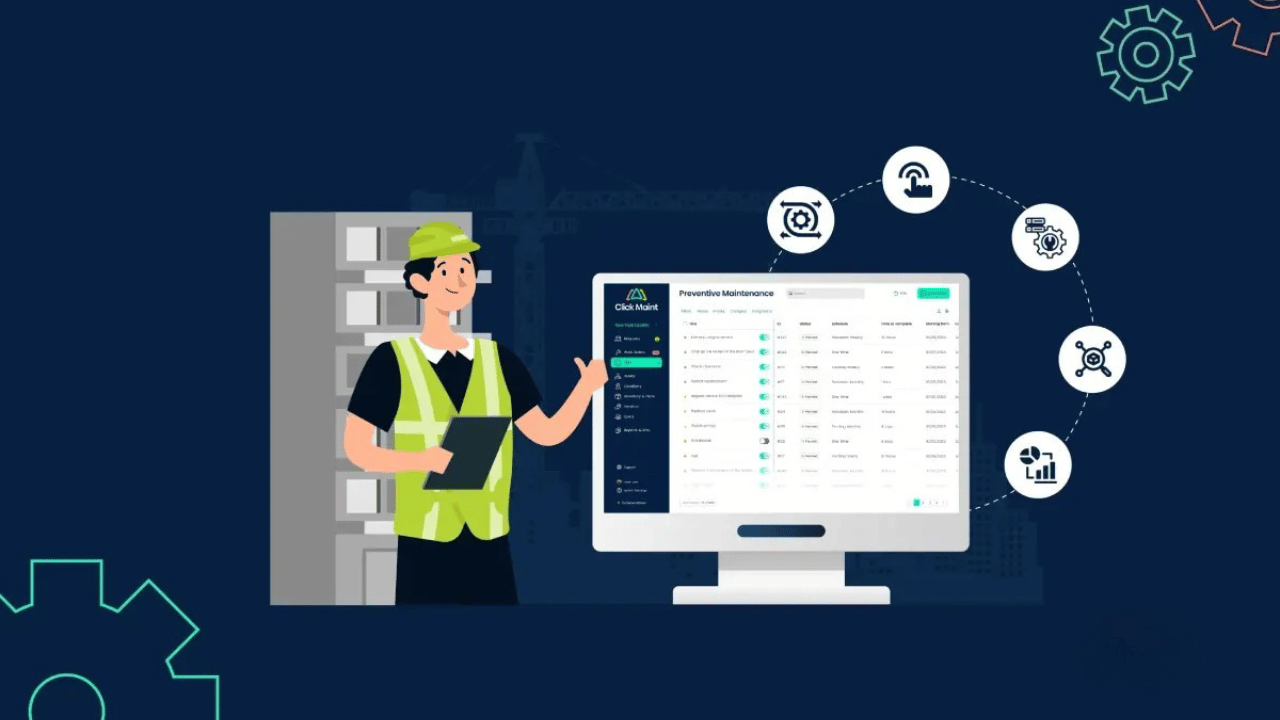Successful management of assets happens to be essential for modern businesses which strive to boost performance and lower expenses while stretching their asset lifetime. A Computerized Maintenance Management System (CMMS) functions as one of the most Importent solutions which helps organizations meet these goals.
CMMS software assists organizations by simplifying maintenance operations to improve asset reliability while creating better decisions through data science analysis.
The Power of CMMS in Asset Management
1. What is CMMS?
Maintenance teams achieve better asset tracking and management outcomes through CMMS which function as asset performance optimization software. Through its functionality CMMS enables organizations to handle automated work order systems and schedule preventative maintenance tasks and record equipment performance metrics along with data analysis capabilities for better decision support.
A well-established CMMS system functions as a central organizational asset management foundation that delivers peak performance across operations together with optimal asset maintenance conditions.
2. How CMMS Drives Efficiency and Cost Reduction
Through advanced task planning CMMS drives operational cost reduction through minimized emergency repairs and maximize asset operational uptime while preventing downtime circumstances. The scheduling capabilities of CMMS systems enable preventive maintenance that lets equipment operate at maximum efficiency as it stretches asset reliability while decreasing maintenance expenses.
Through enhanced inventory tracking functions the software enables organizations to avoid both overstocking and understocking situations by efficiently monitoring spare parts and materials. This management approach saves money for organizations and allows essential parts to be quickly accessible for required maintenance operations.
3. Extending the Lifespan of Your Assets
Asset maintenance practices deliver extended operational periods for all assets. Closely monitoring assets through CMMS reveals performance data combined with failure patterns that enable strategic maintenance preparation. CMMS collects equipment usage data alongside failure modes and repair histories thereby enabling early identification of equipment wear patterns.
The proactive fault detection capability allows maintenance personnel to resolve minor issues prior to critical breakdowns therefore both extending asset lifetime and preventing major capital costs.
Overcoming Common Hurdles in CMMS Utilization

1. Lack of Strategic Roles
The failure of CMMS initiatives usually starts from the lack of executive involvement in asset management strategy development. Organizations seeking to reach their full CMMS potential need to select dedicated personnel who will serve in roles such as asset managers business analysts and reliability action teams.
Human resources with essential positions use CMMS systems to apply them with effectiveness while maintaining accurate data analysis and implementation actions.
2. Poor Data Quality
The outcomes achieved by a CMMS rely primarily on how well users maintain the system data quality. Incomplete or poor data quality produces incorrect reporting which impairs effective decision-making processes. Organizations must maintain accurate data entry across CMMS systems that keep maintenance teams speedily onboard to guarantee that the system provides useful data analytics.
An active data quality plan together with standard audit protocols and validation tests will enhance CMMS data precision.
3. Organizational Misalignment
An improper connection between teams within an organization leads to suboptimal CMMS system effectiveness or underutilization. Each CMMS system requires alignment between maintenance and operations and reliability teams for achieving organization-wide objectives.
Team success with CMMS depends on establishing clear communication links among various operational teams who need to use a common language.
4. Insufficient Training
Inadequate training in the best asset management practices makes implementing the CMMS system difficult. The maintenance team requires training that extends beyond creating work orders through complete proficiency using the software tools needed to track performance metrics and identify system failures and support reliability engineering initiatives.
To achieve optimal CMMS performance organizations must provide all stakeholders with training that familiarizes them with effective system utilization.
5. Failure to Capture Failure Mode Data
Most organizations face difficulties in recording essential failure mode information. Maintenance teams can use failure mode identification results to stop recurring problems while improving their maintenance program schedules.
The failure of organizations to collect essential data through CMMS jeopardizes their ability to detect crucial insights which would enhance asset operational effectiveness. Long-term asset management success requires organizations to capture failure modes for proper analysis and interpretation.
How to Unlock the True Power of Your CMMS
1. Establish Clear Objectives
Your organization needs to set clear objectives which match the main business objectives before deploying CMMS. The establishment of clear industry goals will both direct your CMMS strategy developing framework and provide a common purpose for team members to accomplish the same organizational outcomes.
2. Data Quality Plan
Striking data quality requires you to create an entire strategy for collecting data while verifying its accuracy as well as sustaining its condition. The accuracy of your data and its proper cleaning matters when you need to make educated decisions through your CMMS. The system needs guidelines for collecting and validating asset documentation including machine details alongside operational histories along with maintenance records.
Complete data management through proactive methods ensures your CMMS delivers dependable information for taking forward-looking decisions which drive enhanced asset efficiency.
3. Benchmarking and Continuous Improvement
The key value of benchmarking stands in assessing your CMMS performance level compared to current industry benchmarks. Every period evaluates your system performance against peers in your industry to recognize potential optimization opportunities. Through programs such as Kaizen sessions and root cause analysis your organization can detect process problems to create proactive solutions.
4. Leverage Data for Decision-Making
The main strength of CMMS systems emerges through their advanced ability to process large amounts of asset-related data. The data from your CMMS enables better decisions about asset quality and preventive maintenance intervals and inventory levels.
Periodic key performance indicator (KPI) analysis provides insights into maintenance trends while identifying anomalous data points that let you optimize maintenance approaches.
5. Foster Cross Department Collaboration
Departmental cooperation stands as an essential factor which determines the effectiveness of CMMS implementation projects. The integration of CMMS throughout all asset management operations requires active partnership between maintenance teams and their operational counterparts along with reliability engineering specialists and executive board members from senior management. A system maximizing its effect requires continuous communication and alignment between whole teams.
6. Invest in Ongoing Training and Support
Your teams must stay updated with modern CMMS system features and functionalities by receiving ongoing training alongside constant support. Facilitate attendance of asset management training sessions and conferences together with workshops for your staff to maintain peak performance abilities.
7. Failure Data Capture
Ensure your organization develops documented systems to gather extended failure information which will drive future reliability assessments and maintenance schedule optimization. Asset failure understanding together with root cause analysis drives the optimization of preventive maintenance activities. Your team gains insight into future failures and risk mitigation approaches by recording failure data systematically so they can develop preventive maintenance strategies. Through this approach you can use data to effectively maintain asset uptime while achieving longer overall operational periods.
Conclusion
Your assets reach their maximum potential through proper management tools and a strategic approach to asset management. The implementation of CMMS delivers multiple valuable outcomes which improve asset reliability through streamlined maintenance operations to provide extended equipment longevity.
For CMMS success to happen the program needs to overcome the usual barriers which include bad data quality together with insufficient education and organizational structural issues. The recommended best practices from this article will allow your organization to achieve full CMMS value, which will help us reach operational excellence targets.
FAQ
1. A CMMS system proves beneficial for enhancing asset management operational efficiency levels.
A Computerized Maintenance Management System (CMMS) combines three features by integrating asset information into one location while using automation for work orders and preplanned maintenance activities. The ability of CMMS to monitor asset conditions continuously together with failure predictions enables organizations to minimize repair interruptions and emergency maintenance that led to improved operational efficiency.
Modernized data collection brings teams the ability to focus maintenance efforts by placing tasks in order while optimizing workflow schedules and evidence-based operational decisions which result in extended asset operational periods.
2. Preventive maintenance methods enable organizations to extend asset operational duration.
The execution of Preventive Maintenance (PM) stands as essential for increasing asset operational duration. CMMS allows schedules and track PM tasks to reveal wear signs early so companies maintain equipment peak performance before problems escalate.
The proactive maintenance method achieves two benefits by decreasing repair costs and eliminating unexpected equipment downtime while keeping physical assets operational which defends investment in those physical assets.
3. What benefits will CMMS implement for lowering operational expenses?
The operational costs decrease through CMMS because it improves asset reliability with enhanced performance capabilities. Mixed-maintenance systems decrease emergency intervention expenses by implementing automatic work processes which reduce equipment breakdowns and cut down on maintenance expenses.
Inventory management through CMMS helps determine optimal spare part quantities to minimize procurement expenses so that the organization avoids unnecessary spending. The organization achieves enhanced budget control together with superior asset return on investment through these measures.
4. What effect does CMMS technology have on production levels of maintenance employees?
A CMMS optimizes staff productivity because it simplifies maintenance operations through automated scheduling systems and real-time asset information access. Staff technicians gain full-time access to mobile device work orders and troubleshooting reference materials and historical records which decrease their manual documentation workload.
Staff productivity increases when they have more time for essential tasks because of enhanced efficiency so they deliver faster service with higher quality along with better use of workforce.
5. Asset management benefits from data-driven decision-making through which the approach provides value to asset management.
Organizations obtain important asset performance information and repair details and maintenance expense data through decision-making systems that rely on CMMS technology. Modern organizations achieve better asset decisions because they receive up-to-date data that leads them to make smart decisions about asset repairs and investments.
Predictive analytics enables teams to foresee equipment failures and schedule optimized maintenance thus minimizing expenditures while improving system operational time along with increasing the useful period of vital equipment.



